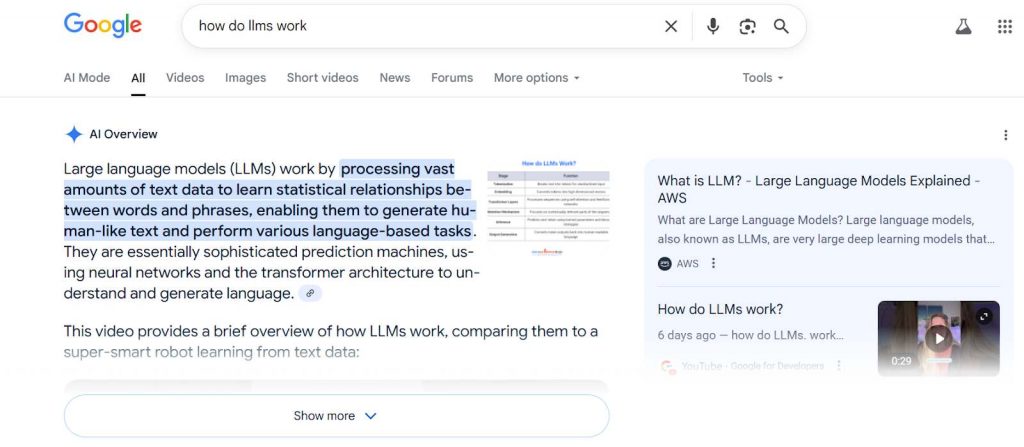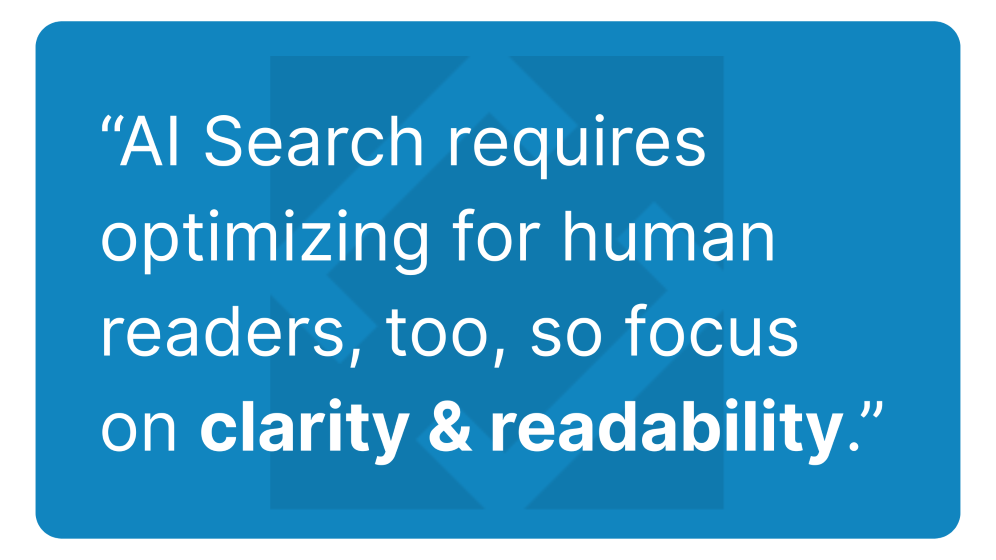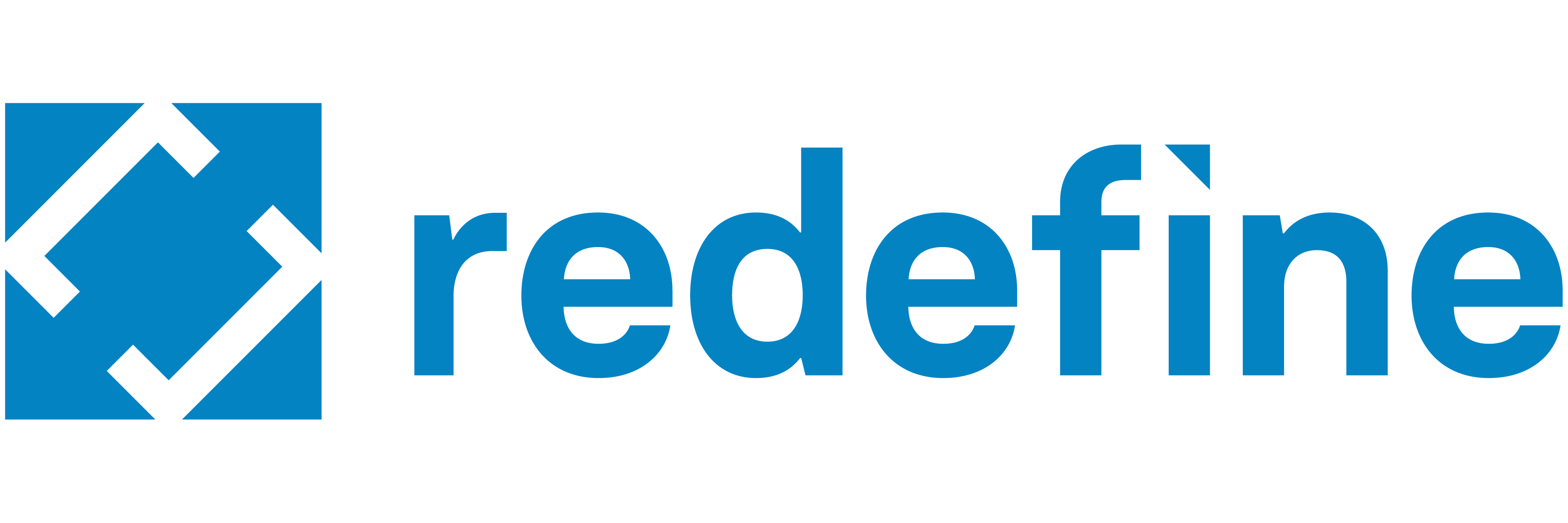- AI Overviews in Google search summarize answers at the top of results using multiple sources, and your content can be one of them if optimized well.
- Optimizing for AI search is similar to traditional SEO, but with a stronger focus on writing clearly for human readers instead of bots.
- Breaking up long paragraphs, simplifying language, and supporting ideas with credible sources can boost your chances of being included in AI-generated results.
- Strategic formatting with clear headings, bullet points, and image captions helps both readers and AI quickly understand your content.
- Keywords remain essential, and well-structured content showcasing those keywords can increase your visibility in AI-powered search results.
There’s no question that we are living in the age of AI-generated search results. Users now expect a short passage at or near the top left of the Search Engine Results Page (SERP), above web results, that provides a bite-sized answer to their query. This section is known as Google’s AI Overview. So what does all this mean for organic SEO?

A typical AI Overview at the top of a Google SERP. Note the highlighted text that specifically targets the original search query, as well as the clickable links to sources on the right.
Is this the end of clicks? Will anyone actually read your content when they can just find an answer within seconds at the top of the SERPs?
While these questions are understandable, there’s no reason to panic. When Google introduced rich results, such as Featured Snippets, brands quickly adapted, understanding that a well-placed feature at the top of the SERPs could actually encourage clicks rather than deter them. AI search results present a similar opportunity.
What we mean by “AI”
AI, or artificial intelligence, is an incredibly broad term. In the context of AI search engine optimization, what we mean when we talk about AI is a type of generative AI called the large language model, or LLM. LLMs include those AI programs most of us are familiar with, such as ChatGPT and Gemini. These programs work specifically with text — or language, hence the name.
But what does that mean, exactly?
Think of the last time you used a LLM, such as ChatGPT or Gemini. Let’s say you asked it for a recipe for chocolate cake. The program has been trained to comb through mountains of text (language) and recognize patterns in relation to your query. It can “understand” your objective — making chocolate cake — and search its “knowledge” of words, phrases, and patterns of communication to help you achieve it.
In this case, it will very quickly “predict” the ingredients and instructions for a chocolate cake recipe. And because we’ve figured out how to make LLMs very effective, the result will probably be delicious!
Search engine AIs engage in this same behavior when they generate AI overviews in the SERPs. Google AI can quickly process your question, then scan the web and provide a response using its ability to quickly analyze and predict language patterns.
This aligns with Google’s long stated goal of prioritizing users’ needs. Now a user doesn’t have to comb through a handful of search engine results, because there’s a reliable summary right at the top of the SERP.
Believe it or not, these AI search results can be leveraged to your advantage with the following content tips.
AI search engine optimization
The good news is that optimizing content for AI search is not much different from the content best practices you should already be following. Because the AI-powered search engines are designed to “read” content like human users do, structuring your content for AI should feel fairly seamless — especially with the guide we’ve provided in this blog.
In short, AI search engine optimization is just the latest version of what you (hopefully) have already been doing to get your awesome content in front of users who need it. But as with any technological advancement, it pays to have a clear understanding of why you’re doing what you’re doing.
Keep reading to learn how AI search results, such as Google’s AI overview, are generated, and most importantly, how to get your content into the mix.
Structuring content for AI search
As with the Featured Snippets of yore, Google AI results are derived from actual online content. The difference is that in a Featured Snippet, direct quotes or sections of content would be displayed without alteration at the top of the SERP. Users could click through to that content for more information.
An AI overview, on the other hand, typically does not display direct quotes or sections from a single piece of content. Instead, the overview is more of a summary, written in unique text generated by the AI itself, based on multiple online sources.
Take another look at the screenshot at the top of this blog, and you’ll notice the hyperlink icon at the end of each paragraph in the AI overview. Those links lead to real web results — and your content could be one of them. That’s what AI search engine optimization is all about.
In other words, the goal is to get Google AI to use your content as a source in the overview provided in the SERPs for target search queries. Because they perceive your content as a trustworthy source, users will be motivated to click through that hyperlink icon to your content for more information.
Below are some fundamental tips to make your content friendly to search engine LLMs:
Write for readers (not bots)
The idea of optimizing content for machines is far from new in SEO. Since the start, a key feature of SEO has been optimizing content for Google’s algorithm, for example by making your content “crawlable” by bots.
But AI search engine optimization is different. When structuring content for AI, you are not dealing with structured data — those pieces of data that users don’t see. Instead, you’re optimizing the content itself, because AI powered search engines are mimicking how human users read that content.
This means that AI search optimization requires you to write for human readers — exactly what you’ve already been doing! Focus on clarity and readability, starting with the following tips:
- Break long paragraphs into shorter, more easily digestible chunks.
- Simplify your language to make your content as accessible as possible. (A good rule of thumb is to keep your text to a sixth-grade reading level, and avoid too much technical jargon.)
- Support your ideas with quality evidence, including hyperlinks to your sources, in order to boost E-E-A-T.
Focus on formatting
Strategic formatting is another important way to optimize your content for AI search. Tags and headings, such as hierarchized H1s, H2s, and H3s, help readers understand how your ideas connect and progress.
Because LLMs are modeled on the way human readers understand text, content that is well-formatted is also ideal for AI powered search engines.

Leverage text features
Again, your goal is to make your content clear and readable. Certain text features allow you to present information so that readers (and thus AI programs) can quickly capture important concepts. These include but are not limited to:
- Bulleted or numbered lists, especially when describing processes with multiple steps
- Including 4 to 5 “Key Takeaways” at the top of a post
- Captions for images and graphics that the reader can see
Don’t forget keywords
Last but not least, keywords remain one of the pillars of good content. AI powered search results make keywords even more important than ever, because LLMs are literally designed to process language patterns.
That makes them very good at finding keywords and phrases related to a user’s search query and making a determination about how useful that content will be in answering the user’s questions.
As always, start with thorough keyword research to generate the short- and long-tail keywords most relevant to your target audience. Then, as you create high-quality content targeting those keywords, use formatting and structure to strategically showcase those keywords and organize your content around them.
Your partner in AI SEO
AI is transforming search quickly. But at the end of the day, Google’s goals remain the same: provide high-quality content to human readers. If this has been your goal too, then optimizing content for AI should be natural, if not easy.
The key is to continue using content best practices while paying close attention to AI search trends. After all, we can only expect more change to come.
Of course, it’s easier to navigate change with a little help from the experts. At Redefine Marketing, we’re always on the lookout for developments in SEO and love finding solutions to new challenges.
If your brand could use guidance in today’s AI-powered digital marketing world, get in touch with our team today!





